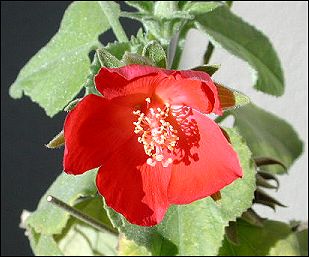

Most of us have seen the somewhat risque class of bumper stickers, such as "Clowns do it funny." One that few non-biologist would understand is "Plants do it with style, but there's a stigma attached." It only makes sense if you know that the style is a portion of a flower's female parts and is attached to the part that receives the pollen, the stigma.
Plants do the reproducing thing in a variety of ways, but a common arrangement puts both the female part, the pistil, and the male parts, the anthers, together in the same flower—the so-called perfect flower. But for many plants, self-fertilization is a no-no. One way to prevent this is to conceal the stigma's receptive surfaces until after the anthers have released their pollen, and then to open them up to incoming pollen from other plants.
Pollen caught on the stigma germinate to form pollen tubes that grow
down the style to the ovary, there to fertilize the ovules. Strange from a
vertebrate's point of view, but the plants seem content.

Contributor: Arthur H. Harris, Laboratory for Environmental Biology, Centennial Museum, University of Texas at El Paso.
Desert Diary is a joint production of the Centennial Museum and KTEP National Public Radio at the University of Texas at El Paso.

A perfect flower (mallow family—Malvaceae). The anthers are the numerous light-colored structures clustered around the central axis of the flower; three "double" stigmas can be seen protruding beyond the mass of the male parts (at the bottom of the mass of stamens).
TAMU, diagram, definitions, photos.